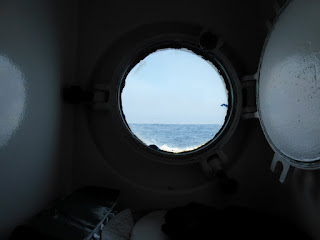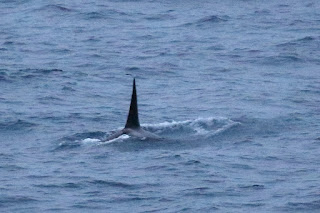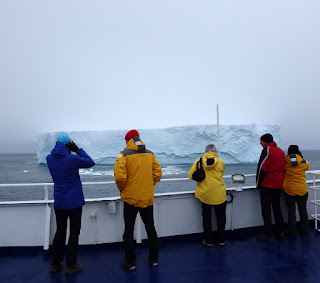It was nice
to sleep in a bit today by about an hour or so. However, we did lose an hour of sleep since we set the clocks back to match the time while in Antarctica. They have strict rules on where and when you have landings, so it maximized our time.
As we sailed
towards South Georgia the ship started a pool to see who could guess the time
and date of the first iceberg sighted that is at least half the size of the
ship.
I'm King of the World!
OK, I'm done being king of the world
where the zodiacs are stowed when not in use
view out of our porthole
This time
the call for whales was for Orcas. Only we later found out they weren’t just
any Orca, but an Orca type D which are extremely rare. I don’t remember if they
said there have only been like 14 sightings or photos, but anyone getting a
good shot could make it into the journals. While one
person got a shot that was good enough to identify it, it may or may not make
it into any scientific journals.
“Type A Orcas
are the kind most of us are used to picturing -- enormous, black and white,
with white eye patches; type B are a bit smaller, and more gray on their darker
portions than black; and type C is the smallest orca, also more grayish than
black, with white eye patches slanted at an angle to the body.”
We had great views of them, but of course photos were hard to come by.
Orca Whales
whale blows
We also saw
our first Wandering Albatrosses today. You may notice a pink area around the neck in some of the photos. "The pink staining on the necks
of Wandering Albatrosses has been explained as due to
"the birds snorting or sneezing explosively while in flight to expel
fluid from their nasal tubes. The
exhaled liquid is a mixture of a saline secretion from the salt glands (that
all seabirds have) and stomach oil stained pink (or orange) from the birds'
diet."
The
Wandering Albatross has the largest wingspan of any living bird, typically
ranging from 8 feet 3 inches to 11 feet 6 inches, with a mean span of 10 feet 2 inches. That's an impressive bird!
Wandering Albatross
Wandering Albatross
Wandering Albatross
Wandering Albatross
Wandering Albatross
Great Shearwater
Southern Giant Petrel
Southern Giant Petrel (shared photo)
During these
two days, we also crossed the Antarctic Convergence – the area in the ocean where
cold water from Antarctica meets the relatively warmer water of the South
Atlantic. It is an important boundary, both because the mixing of the two
masses of water causes nutrients to well up that support a great concentration
of life, and because the convergence marks a boundary that many species of
birds and sea animals do not cross. From a biological/ecosystem perspective,
the Convergence marks the boundary of Antarctica, because south of the
Convergence, the very cold sea water (it was 0-2 degrees Celsius constantly
from this point on) influences the climate and the lives of the birds and
animals that are hardy enough to live there.
The ocean
was a bit more turbulent as we crossed the convergence.
When not out on deck we attended the lectures. Will, the geologist on board was exuberant and had a good sense of humor, often poking fun of himself as he realized for most people on the ship they weren’t all that interested in the subject, but of course it was interesting and nice to have him explain what we were seeing.
He started today's lecture with the question, "What are the 3 main types of rock?" Of course the 10 year
olds hand went up and others chimed in to name sedimentary, metamorphic, and
igneous rocks. Will said “well, that’s wrong; it’s Classic, Hard & Punk.”
Ha ha.
Here is today's program:
07:00
- 08:00 A Continental Breakfast is served in the Main Lounge
08:00
- 09:00 Breakfast is served in the Dining Room
09:30
Please join our Historian, Hadleigh, for his presentation “Lifting the Veil -
The Quest for Terra Australis Incognita” in the Main Lounge
11:15
Our Rockstar Geologist, Will, will be in the Main Lounge giving his
presentation, “Mighty Mountains and Explosive Volcanic Island Chains - The
Evolution of the Scotia Sea & Formation of the Antarctic Continent”
12:30
Lunch is served in the Dining Room
14:30
Please join Sam, for her presentation, “An Introduction to Polar Photography”
in the Main Lounge
16:00
Our Ornithologist, Mark, will be in the Main Lounge giving his presentation, “Albatrosses
of the Southern Ocean”
18:30
Please join the Expedition Staff for a Re-cap & Briefing
19:30
Dinner is served in the Dining Room
21:15
Evening entertainment in the Main Lounge will feature Jazz Night
“The 3 great elemental sounds in nature are the sound of rain, the sound of wind in a primeval wood, and the sound of outer ocean on a beach. I have heard them all, and of the 3 most elemental voices, that of the ocean is the most awesome, beautiful and varied.” - Henry Beston
Sunrise: 04:10 Sunset: 20:39
December 24 - Christmas Eve at Sea - Shag Rocks
Today, we had a Bio Check as required by South Georgia. We had to have all of our gear checked for any seeds or contaminants that we may have brought back on our clothing from the Falklands before we can disembark in South Georgia. They had us wash our boots again and they checked all pockets, velcro on all clothing, inside of backpacks and gloves etc. They had vacuum cleaners there to help remove anything that might have been missed.
We spent as much time out on deck as we could in between lectures and the Bio-check. We saw our first penguins floating by on an iceberg. (small icebergs are known as "bergy bits" We saw a lot of Antarctic Prions flying around the ship. We also saw more Whales. and some playful seals.
Humpback Whales
a seal flying through the water
playful seal
Gentoo penguins porpoising past the ship (shared photo)
Wilson's Storm Petrel
Wilson's Storm Petrel
White-chinned Petrel
Antarctic Prions
Antarctic Prions
Antarctic Prions
Antarctic Prions
Antarctic Prions
We approached Shag Rocks, which were beautiful and full of Shags nesting on just about every inch of them. We also started seeing more icebergs. Though, I think the winner of the iceberg contest was seen yesterday.
Approaching Shag Rocks
nesting Antarctic Shags covered most of the rocks
beautiful blue ice of the iceberg
lone penguin floating on the ice
out on deck with the iceberg behind me
Tonight they offered a traditional Christmas dinner (as well as other choices) and then we met in the lounge for bananas foster and singing along to Christmas carols that the staff sang. At some point someone started a Conga line around the lounge.
chef with a turkey
Olga & me
Victoria
our cabin steward Mark is on the left
Shane and me looking all "festive"
We left after that since we had early morning excursions and full day excursions in South Georgia for the next 4 days.
Here is today's program:
Approaching South Georgia – Sea Day
07:00 - 08:00 A Continental Breakfast is served in the Main Lounge
08:00 - 09:00 Breakfast is served in the Dining Room
09:15 Please join pinniped specialist, Mikolaj, for his presentation, “Dogs of Sea: Seals of South Georgia” in the Main Lounge
11:00 Our Ornithologist, Mark, will be in the Main Lounge giving his presentation, “Penguins of the Southern Ocean”
12:00 Lunch is served in the Dining Room
13:45 Please join Shane for an introduction to South Georgia and a review of our mandatory IAATO requirements.
A mandatory Bio-security Cleaning Procedure will take place after this presentation - everyone will be called by cabin to come to the Main Lounge. Please listen for announcements.
16:00 Please join historian, Hadleigh, in the Main Lounge for his presentation, “The Weddell Sea Party: The Story of Shackleton’s Imperial Trans-Antarctic Expedition”
18:30 Please join the Expedition Staff for a Re-cap & Briefing
19:30 Dinner is served in the Dining Room
21:00 A Special Dessert will be served in the Main Lounge
“There must be a beginning of any great matter, but the continuing unto the end until it be thoroughly finished yields the true glory.” -Sir Francis Drake 1587
Sunrise: 04:34 Sunset: 22:13
We eagerly awaited Christmas morning and the wonders South Georgia would bring. It is known as "the Galapagos of the South" because of it's sheer numbers of wildlife.
You may have noticed that the further south we go, the shorter the nights become. Really just a couple hours of "almost darkness".






























































So fun to see your wildlife pictures. I got an education on whales. I didn't realize there were different classes of whales in a subcategory. Those icebergs were beautiful, Steve and I enjoyed seeing icebergs in Alaska last year. The floating ones you saw were much larger. It looks like your outerwear came in handy. Can't wait to read and see more.
ReplyDeleteThanks for following along. Yes, most of what we saw was much larger than Alaska. (and we LOVED Alaska)Both places have a way of reminding you how "small and insignificant" we are. Yes, we got an education as well on whales...who knew?
ReplyDelete